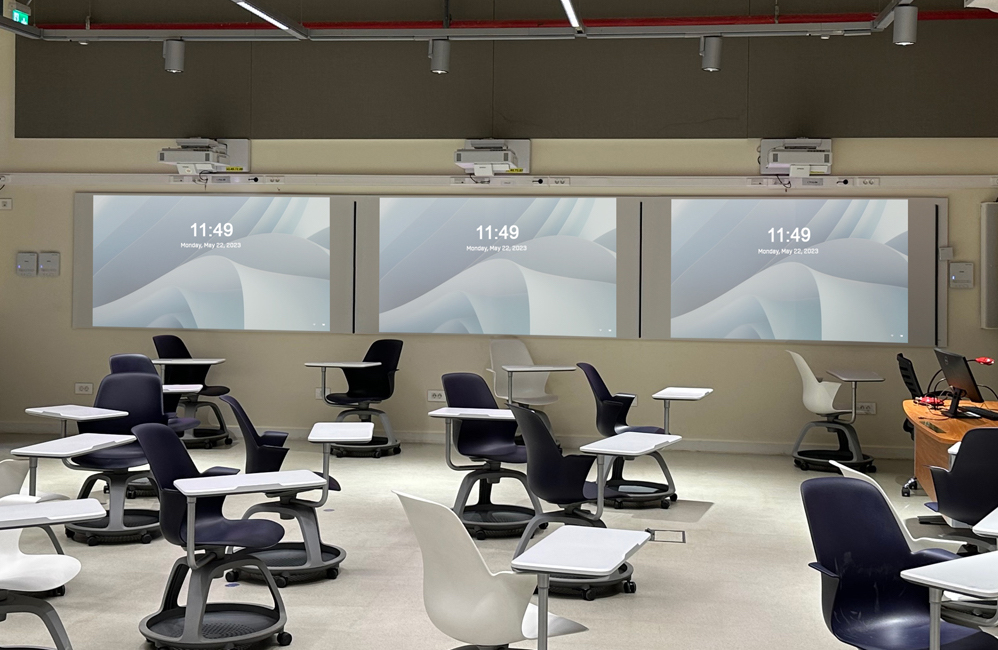
The American University of Cairo’s sprawling campus spans 260 acres, with a diverse community of nearly 7,000 students from 70 countries working toward a liberal arts education. As part of AUC’s mission to provide state-of-the-art facilities for advanced research, innovative teaching, and lifelong learning, the in-house AV and IT teams came together to address a common challenge in the higher education community: how to effectively bring the physical and the remote together.
“We call it dual delivery,” said Amir Gamal, associate director for IT Academic Support Services. “Like most universities, we wanted to develop a permanent model where the instructor can teach classes to students both on and off-campus, and bridge the physical and remote divide.”
It was a big job to undertake with such a small team on campus, who would ultimately be responsible for systems design, equipment procurement and overseeing all AV and IT integration phases across 135 dual-delivery classrooms. “The existing technology footprint varied across many of these spaces, though most contained a projector and display screens along with standard computers and IT infrastructure,” Gamal said. “What we lacked was a consistent backend infrastructure to connect and control all these technologies, including switchers and extenders that could also help us better reach remote learners.”
Gamal and his colleague, Abdallah Kassam Hussein, who serves as officer of classrooms, first identified some defining characteristics for potential technology choices. The equipment needed to be easy to use for both student and instructor, including simple interaction with AV equipment through a control interface. They also favored durable equipment that wouldn’t require substantial maintenance, given the spread of equipment over all 135 learning spaces. The equipment would also need to be fully 1080p HD-capable to ensure consistent quality of instruction and support for high-resolution images.

Finally, they wanted equipment that could support several room functions in one device. When it came to extenders, that meant a solution that could send both HDMI and USB signals over one Cat 6 cable. While there were several vendors under consideration, they set their sights on Atlona for several reasons. “There was no question their HDBaseT extenders, like others, had the bandwidth to handle HDMI and USB extension,” Hussein said. “When you start adding up the number of spaces we needed extenders for, the monetary investment quickly escalates. Atlona had the best price point of any vendor we seriously evaluated, and they were proven to work with our existing Logitech cameras and Epson projectors.”
The price point is an important part of the strategy behind Atlona’s Omega AT-OME-EX-KIT-LT, an HDBaseT extender kit that was designed precisely to provide a value-priced configuration optimized for smaller learning and meeting spaces with shorter extension requirements. The AT-OME-EX-KIT-LT, which features a transmitter and receiver, extends 1080p/60 HDMI and USB signals up to 230 feet (70 meters). Its USB 2.0 interfacing and extension capabilities enable interoperability with Zoom for remote learners who participate via the platform.
The university hired an external firm to run new Cat 6 cabling through all the learning spaces, while the in-house team, Academic and Campus Technology Support Services (ACTSS), installed the extenders. “We used this cable to transfer images and connect our Logitech cameras in the back of the classroom to the podium,” Hussein said. “Images are transferred from a classroom PC to a Samsung HD LED display—each classroom has one display—and we receive the output from the camera via USB, which is transferred to the computer. The result is absolute reliability for HDMI and USB transport, improved camera output resolution, and uniformity across all spaces for easier troubleshooting when required.”

Advanced Room Requirements
While equipping learning spaces with extenders was essential to equalizing in-person and remote learning experiences, the ACTSS team came away with some additional technology upgrades upon evaluating Atlona’s broader product line. That included two 4K HDR matrix switchers and a Velocity control system for two specific learning spaces.
“The Visual Arts program prepares students for careers in graphic design, animation, film and more, and the instructors have specialized content to show their students that benefits from higher resolution image presentation,” Gamal said. “We added two of Atlona’s 4×4 HDMI matrix switchers to podiums inside two learning spaces that use higher quality content during instruction, as well as a Velocity system to control the switchers plus all AV source and destination equipment.”
The ACTSS team selected Atlona’s AT-HDR-H2H-44MA switcher, which is ideal for full-motion, highly detailed presentations of 4K graphics. Separately, the AUC’s IT team purchased two Velocity AT-VGW-HW-3 hardware server gateways, each of which can support AV control for up to three rooms. The Velocity gateways, the final systems to go online as of press time, will replace the legacy control system.
“Velocity will exist on a separate virtual network and will not connect directly to our main network, and we understand that Velocity will be mainly used for AV control in meeting rooms,” Hussein said. “However, the same IT network team will make most of our AV technologies accessible on the Wi-Fi network so that students and instructors can see them and control them on their devices.”
“We have come a long way with the technology upgrades of this project, and the new and improved services they enable within our dual-delivery classroom,” Gamal said. “It wasn’t long ago that our learning spaces were all VGA. Now we have full 1080p HD capability in all classrooms plus some 4K, and a fully interoperable infrastructure for modern hybrid learning models.”







